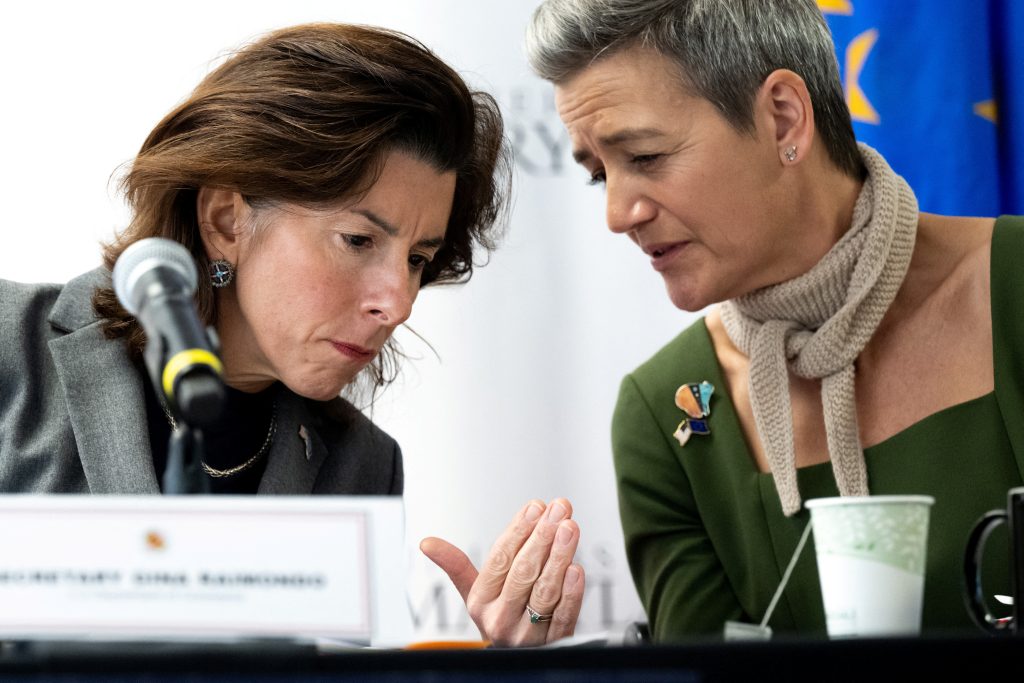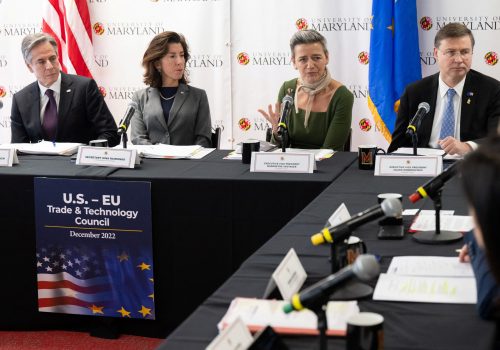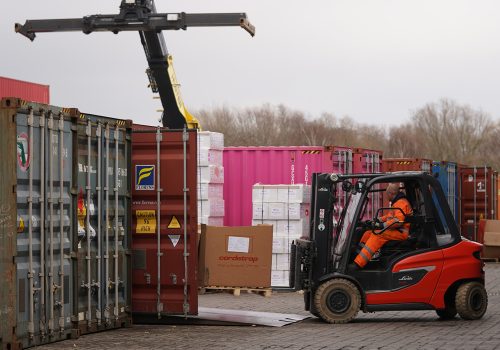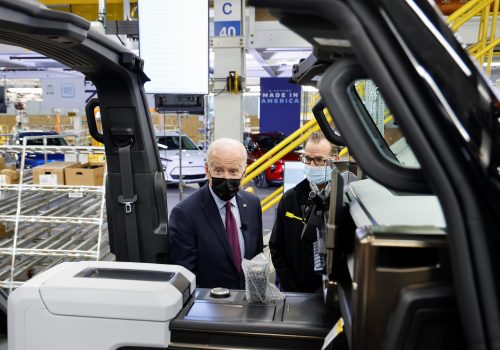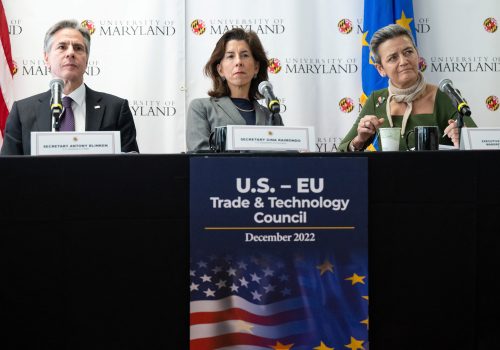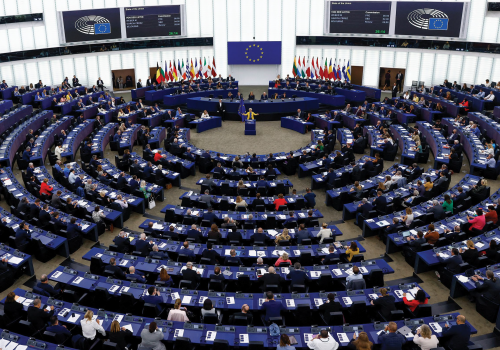The United States and the European Union (EU) appear poised to take joint action on some of their biggest common challenges in trade and technology, including on export controls, China’s non-market practices, and possibly even artificial intelligence (AI).
Those actions are set to be unveiled on May 30-31, when US and EU officials convene in Luleå, a small city in northern Sweden, for the fourth meeting of the US-EU Trade and Technology Council (TTC). What can Europeans and Americans expect to see at this meeting? And can Brussels and Washington surmount lingering obstacles to transatlantic cooperation on trade and technology? We gathered rapporteurs from the TTC Track 2 Dialogues series—a forum for policy debate and stakeholder dialogue organized jointly between the Atlantic Council’s Europe Center and the Brussels-based European Policy Centre—to share their insights.
Click to jump to an expert analysis:
Frances Burwell: The TTC must help the US and EU confront their geopolitical challenges
Georg Riekeles: The first step to addressing China is improving the EU-US relationship
Andrea García Rodríguez: The TTC meeting must meet the moment on AI
Olga Khakova: The TTC is timely and powerful—but it needs to launch into action in Sweden
Philipp Lausberg: The TTC should lay out the path for a transatlantic green industrial policy
Annika Hedberg: The TTC should help unleash transatlantic power for sustainable prosperity
The TTC must help the US and EU confront their geopolitical challenges
When the TTC was announced in June 2021, many analysts and stakeholders believed it could usefully address the severe asymmetries between US and EU approaches to trade and technology, while also repairing the transatlantic rifts that had emerged during the Trump administration. That optimism was almost immediately challenged as the TTC leadership agreed that pending legislation was excluded from the discussion agenda and as negotiations over data privacy and green steel were put on separate tracks. Instead, the TTC focused on laying small stepping stones toward future cooperation on AI, standards setting, supply-chain transparency, small and medium-sized enterprises, and external trade issues such as the use of forced labor.
Since Russia’s full-scale invasion of Ukraine, the TTC turned from a moderately useful mechanism for coordinating US-EU standards-setting efforts to an important forum for dealing with challenges posed by China and Russia. The TTC quickly became the transatlantic forum for coordinating export controls on Russia, dove deeper into tracking supply chains, focused more intensely on tech and democracy issues, and began to experiment with countering Chinese influence in the Global South through small projects in Kenya and Jamaica.
These new priorities are not, however, the ones most valued by stakeholders from the business community, whose support for the TTC has become rather tepid. Those stakeholders focus on instances of potential protectionism or overly intrusive regulation, such as the possible forced sharing of data under the EU Digital Services Act. The TTC has increased its stakeholder engagement in recent months, with a focus on standards for 6G rollout, digital trade, e-mobility, AI taxonomy, and other issues. These are important and will help the United States and the EU develop a foundation for future technical and economic cooperation.
But these “deliverables” should not be the only measure of the TTC’s success. Perhaps even more important has been the increase in communication between US and EU officials at all levels, but especially among the leadership. European concerns about the US Inflation Reduction Act (IRA) could have escalated sharply without the relationships and communication channels constructed by the TTC. This has also contributed to a visible transatlantic convergence of views around AI, supply chains, subsidies, investment controls, and other issues.
The question now for the TTC is whether it can steer the growing use of economic measures to address geopolitical concerns in a way that is complementary and cooperative. The TTC will need to expand its work on supply chains from simply mapping to jointly addressing issues. It will also need to seek greater transatlantic cooperation aimed at limiting the spread of disinformation via social media and AI. And the United States and EU must figure out, through the TTC, how they can jointly approach countries with significant quantities of rare-earth elements so that they do not compete over resources to their mutual detriment. Finally, the TTC will need to navigate a way through the green transition that enhances US and EU resilience without weakening the transatlantic partnership (a weakening that seemed likely when the IRA first emerged).
The TTC has evolved since its founding in 2021, and it will continue to do so. The true test of its relevance will not be whether it builds cooperation in a particular standard-setting body—although that is useful—but whether it helps the United States and EU confront their current geopolitical challenges.
—Frances Burwell is a distinguished fellow with the Atlantic Council’s Europe Center and a senior director at McLarty Associates. She is also a rapporteur for the data and technology-regulation track of the TTC Track 2 Dialogues series.
The first step to addressing China is improving the EU-US relationship
Highs and lows have marked the EU-US Trade and Technology Council since its inception in 2021, but the definitive low point came at the most recent ministerial meeting in December. Officials on both sides were putting on brave faces, despite being fundamentally at loggerheads over the IRA’s discriminatory and protectionist measures.
A central question at the Sweden meeting inevitably will be whether the EU and the United States can agree on how to work effectively together—not against each other—to address challenges posed by China. China was in many ways a raison d’être for the TTC from the beginning, with the United States wanting a tech ally against China and Europe wanting a deeper transatlantic economic space.
In early phases this worked well, and a convergence of views on China was further buoyed by Russia’s invasion of Ukraine and unprecedented transatlantic collaboration on sanctions. Here in Brussels, the word was that Europeans and Americans had rarely before thought so similarly about China.
Then came the IRA in August 2022 and much changed. In Europe’s eyes, it became clear not only that the continent could become collateral damage from the US-China rivalry, but that Washington’s actions bluntly aimed to establish US economic domination by capturing European investments, value chains, and industry. Fundamentally, it brought to the fore the central difficulty with attaining economic security: Partners can also be rivals.
Europe can ill afford Washington’s logic of economic confrontation with China and unruly competition across the Atlantic. German Chancellor Olaf Scholz’s visit to Beijing last November demonstrated this divergence. While Washington insists on an economic and technological decoupling from China, Berlin still believes in and plays a game of mutual dependency, as symbolized by the parallel investments of German industrial flagship BASF in Zhanjiang and of the Chinese state-owned Cosco in the port of Hamburg.
Are there any grounds for more optimism on transatlantic agreement now? Not all Europeans are ready for a hardline approach to China (as highlighted also by French President Emmanuel Macron’s recent Beijing visit), but they agree on the need to protect themselves against an increasingly hegemonic and coercive power. As von der Leyen said recently during a speech she gave on EU-China relations at the European Policy Centre, through the decade that Chinese leader Xi Jinping has ruled, there has been a clear push to “make China less dependent on the world and the world more dependent on China.”
The United States and EU will meet in Sweden a week after attending a momentous G7 Summit in Japan. But succeeding at the TTC is much harder than at the G7 because it is not enough to produce carefully worded communiqués, it’s about tangible deliverables and actions. Doubts about the council’s effectiveness have marred the TTC since its inception. In Sweden, US-Europe convergence on China now depends on being able to deliver concretely on trade, industry, and economic-security priorities. This includes forging a viable partnership on critical minerals, agreeing on transparency and rules for green-industrial subsidies and making progress on methodologies for carbon accounting. It also hinges on taking credible steps toward deepening transatlantic trade, because the first step in building common economic security is certainly to remove obstacles and discriminatory practices between one another.
—Georg Riekeles is an associate director and head of the Europe’s political economy program with the European Policy Centre. He is also a rapporteur of the trade and supply-chains track of the TTC Track 2 Dialogues series.
The TTC meeting must meet the moment on AI
The meeting in Sweden will be fundamental for the continuity of the TTC over the next few months. Since the TTC’s last meeting in December, the European Parliament cleared the way for a plenary vote on the AI Act (slated for mid-June) and the use of OpenAI’s ChatGPT has skyrocketed, sparking a variety of reactions to generative AI. China has unveiled its own model, Baidu’s Ernie Bot, and several European countries have accelerated policies to respond to AI’s challenges. For instance, Italy banned ChatGPT until OpenAI addressed regulators’ concerns. All in all, these developments have raised new questions about how to govern general-purpose AI systems to ensure they remain aligned with democratic values. A transatlantic response is essential in addressing these concerns.
Following the publication of the Joint AI Roadmap after the TTC meeting in December, it is important that the coming meeting unveils developments in this area. This is not only because challenges are multiplying rapidly, but also because the roadmap presents a unique opportunity for the United States and the EU to design common approaches to governing emerging technologies—and if democratic powers want to be the ones to set international technology standards they shouldn’t let that opportunity go to waste. These approaches to addressing AI can be replicated when addressing other technological challenges, such as challenges posed by the Metaverse or quantum computing. That is a reason why this next meeting is crucial: It will either show that the TTC can take real action or it will bring the council’s diplomatic weight—and its ability to advance the global governance of emerging technologies—into question, increasing the risk that the multistakeholder community loses interest in such collaboration.
—Andrea García Rodríguez is the lead policy analyst for digital at the European Policy Centre and a rapporteur of the data and technology regulation track of the TTC Track 2 Dialogues.
The TTC is timely and powerful—but it needs to launch into action in Sweden
An indispensable resource for deploying technology and trade tools to address the most urgent climate and energy security threats, European leaders need to reinvigorate the TTC’s full potential in coming meetings. This is especially critical in the face of other challenges facing Europe, not least Russia’s brutal war and escalating global tensions with China.
The TTC’s lack of progress on the green transition track since its last meeting in December is not indicative of the TTC’s potential to address the trade, supply-chain, and technology barriers that arise when forging secure and low-carbon economies on both sides of the Atlantic. The May meeting could be the springboard to launch this track into action.
To achieve more meaningful clean-energy outcomes, policymakers must use the upcoming meeting to outline tangible goals for its existing green transition work streams, including those related to semiconductors, the Transatlantic Initiative on Sustainable Trade, export controls, the Talent for Growth Task Force, additive manufacturing, the recycling of plastics, and alignment on electric-vehicle charging infrastructure. Policymakers should also utilize this meeting to ensure that trade and tech policy is maximizing efforts to curb emissions and strengthening energy security. To do so, the EU and the United States will need to more broadly align on standards related to measuring carbon and environmental impacts, including by clarifying the role of digitalization in decarbonization and the role of digital solutions in streamlining carbon-emissions measurements and verification.
One particularly meaningful action the TTC can focus on is efforts to build on its export-controls track by improving transparency and information sharing regarding export-control evasion—particularly around the energy sector, since the energy industry is one of Russia’s biggest sources of funds for its war. The TTC’s work on the critical-minerals supply chain could reinforce the work of the US-EU Task Force on the IRA. In areas in which the TTC may not have capacity to do the work, the platform could still outline key opportunities for action and work closely with the existing mechanisms, such as the World Trade Organization, the US International Development Finance Corporation, the European Bank for Reconstruction and Development, the Export-Import Bank of the United States, the US-EU Energy Council, and others.
The TTC won’t be the panacea for all trade and technology challenges. However it is a timely, powerful body for exchanging information and best practices, aligning standards, forging transparency, and testing out audacious ideas—and most importantly, identifying concrete actions for US-EU cooperation.
—Olga Khakova is the deputy director for European energy security at the Atlantic Council’s Global Energy Center. She is a rapporteur for the green transition track of the TTC Track 2 Dialogues.
The TTC should lay out the path for a transatlantic green industrial policy
The IRA cast a shadow on the previous TTC meeting outside Washington in December. Its local content requirements—which extend subsidies to clean tech goods produced only in North America—is perceived in the EU as an attempt to capture the bloc’s manufacturing base. Since then, the EU has launched its own Green Deal Industrial Plan, and both sides have been keen to limit the fallout of the IRA and move ahead together amidst mounting geoeconomic challenges. The two sides set up a special US-EU Task Force on the IRA, and European Commission President Ursula von der Leyen visited US President Joe Biden at the White House where they announced their intent to conclude a targeted agreement on critical minerals and put in place a Clean Energy Incentives Dialogue. This presents the United States and EU with four tests for showing whether they can coordinate on green industrial policy and economic security at their upcoming Sweden meeting—and beyond.
The first test is how far the United States will accommodate EU demands to adjust the elements of the IRA that are “discriminatory” against European companies. The aforementioned critical minerals agreement would allow relevant raw materials extracted or processed in the European Union to count toward requirements for clean vehicles delineated in the clean-vehicle tax-credit section of the IRA, effectively circumventing the “made in America” provisions. Although the form this agreement takes—and whether it could be extended to a wider set of European products—is yet to be determined.
Second, the United States and EU will be tested on whether they can better coordinate industrial incentive programs in the future. While expectations on fundamental changes to the IRA are low, its negative fallout for the EU has also been blamed on a lack of institutionalized coordination on transatlantic industrial policy. The new Clean Energy Incentives Dialogue presents the TTC with the opportunity to correct this fault by creating a better understanding of mutual interests and vulnerabilities through increased information sharing. However, it is unclear whether information sharing and closer coordination will be enough to prevent one side from granting advantages to its industry at the expense of the other in the future.
A third test is how the two sides can facilitate a more coordinated and effective approach to green industrial policy on the international level: for example, with respect to non-market practices by third parties such as China, but also in multilateral fora such as within the Group of Seven (G7) Partnership for Global Infrastructure and Investment. The two sides will be tested on whether they can tackle their economic-security challenges while also fostering sustainability and development in third countries.
A fourth test will be whether the United States and EU are willing to cooperate deeply enough in the global scramble for critical raw materials. This includes bauxite, cobalt, lithium, and nickel, which are necessary for clean-tech products such as batteries, wind turbines, and electric vehicles. So far, there has been little cooperation in this field, but a coordinated strategy on these critical raw materials has huge potential given the EU and United States’ combined economic might and their similar geopolitical interests.
—Philipp Lausberg is a policy analyst in the European Political Economy Programme at the European Policy Centre.
The TTC should help unleash transatlantic power for sustainable prosperity
The benefits of enhanced transatlantic cooperation on the green agenda are immense—and wait to be seized. Collaborating in creating more sustainable energy, mobility, and food systems, and improving production and consumption patterns, would lead to greater resilience, security, and prosperity. It can benefit consumers, companies, and workers. It would lead to better jobs, cleaner air, and healthier societies. It would allow us to address the climate, environmental, and resource crises more effectively.
Thus, it is no surprise that the EU and the United States have committed to strengthening and accelerating much-needed transatlantic collaboration on the green transition under the TTC. What is disappointing, though, is how slow the progress on the green transition track has been, despite the benefits that such collaboration promises.
The upcoming TTC meeting should bring new momentum into these discussions. There is no time to waste. This world is fraught with geopolitical tensions—fueled by Russia’s war in Ukraine and China’s unreliability as a partner—which also influence global supply chains and access to resources. The climate emergency, environmental degradation, and pollution are threatening life as we know it and demand our urgent attention. It is vital for the EU and the United States to work together and with like-minded countries if they wish to succeed in addressing these multiple challenges.
Some progress has already been made. A good example is the ongoing attempt to develop similar electric vehicle charging infrastructure across the Atlantic. The potential for collaboration, however, is so much greater than what has been realized thus far. To achieve the green transition, including the clean energy transition, it’ll be essential for the EU and the United States to team up on ensuring they have access to needed resources (i.e. materials, technologies, and skills); creating resilient and sustainable supply chains; and reducing risky dependencies. The EU and the United States should also do more to explore transition pathways to a circular economy, which should include eliminating trade barriers for recycled materials and enhancing the durability, reusability, and recyclability of materials and products needed for the green transition.
The TTC is far from the only channel for the EU-US collaboration. However, it is in the interest of both to use the TTC platform to step up efforts toward creating a transatlantic marketplace for products and services that are urgently needed to address planetary crises. The EU and the United States must turn competition and partnership into a transatlantic green power that will enhance prosperity across the Atlantic.
—Annika Hedberg is the head of the programme for sustainable prosperity for Europe at the European Policy Centre. She is a rapporteur of the green transition track of the TTC Track 2 Dialogues.
About the “TTC Track 2 Dialogues” series
The “TTC Track-2 Dialogues” series was created by the Atlantic Council and the European Policy Centre to foster policy debate and stakeholder dialogue on the issues covered by the US-EU Trade and Technology Council. The series aims to connect US and EU stakeholders for discussions along three thematic tracks relating to the TTC’s priorities: (i) trade and supply chains issues; (ii) data and technology regulation, and (iii) the green transition. Each track consists of two separate workshops with transatlantic stakeholders, which are used to inform short policy briefs containing concrete recommendations for US and EU decision makers.
Further reading
Fri, Dec 2, 2022
The big problems you won’t hear about at the EU-US Trade and Technology Council
New Atlanticist By Kenneth Propp
The TTC’s exclusion of the issues of greatest import in transatlantic economic affairs does not inspire confidence that it will prove to be a lasting institution.
Mon, Dec 5, 2022
The US and EU need a sturdier structure to resolve their trade squabbles
New Atlanticist By Clete R. Willems
Monday’s TTC ministerial meeting did not make major progress on sensitive climate and digital issues. The council needs to evolve now to solve the toughest disputes.
Wed, Nov 2, 2022
Digital sovereignty in practice: The EU’s push to shape the new global economy
Report By Frances Burwell, Kenneth Propp
What does the European Union's push for "digital sovereignty" mean in practice? Frances Burwell and Ken Propp provide an update to digital sovereignty and its transatlantic impacts.
Image: US Secretary of Commerce Gina Raimondo and European Commission Executive Vice-President Margrethe Vestager participate in a US - EU Stakeholder Dialogue during the Trade and Technology Council (TTC) Ministerial Meeting at the University of Maryland in College Park, Maryland, December 5, 2022.
